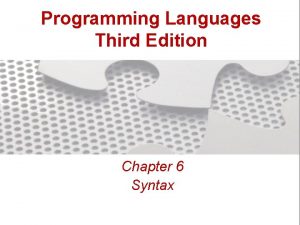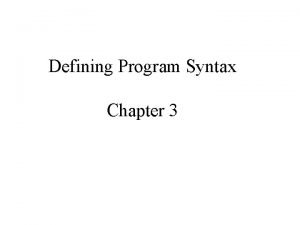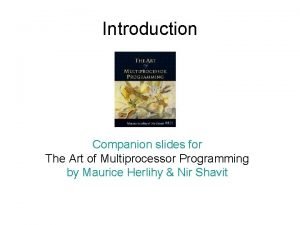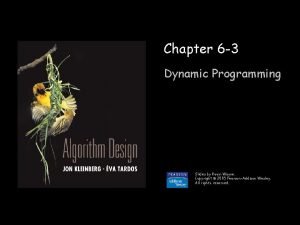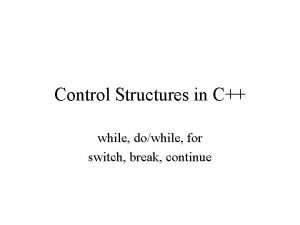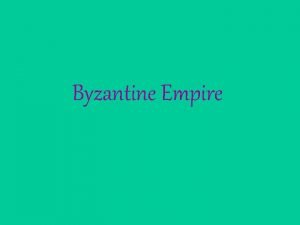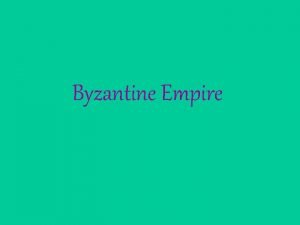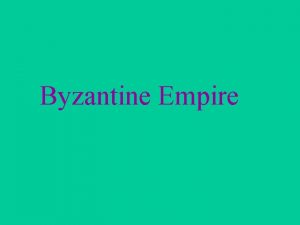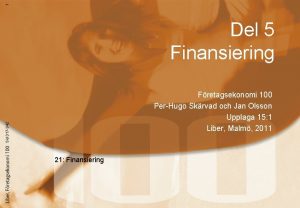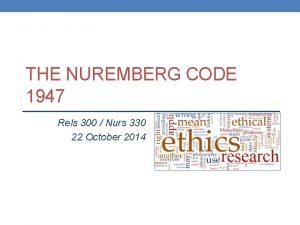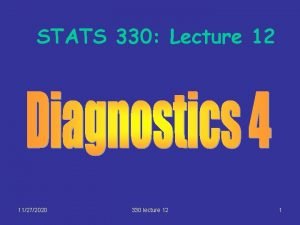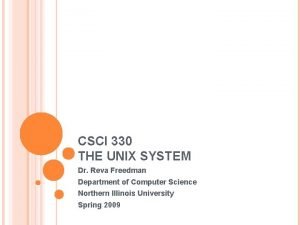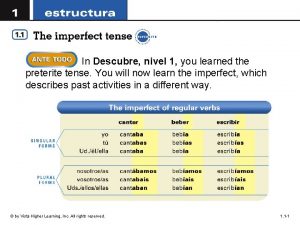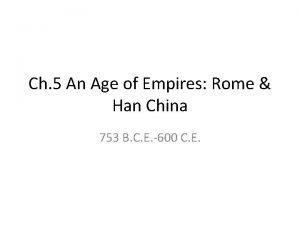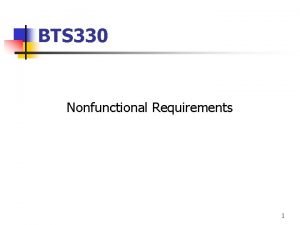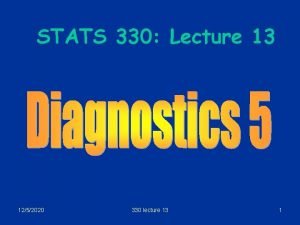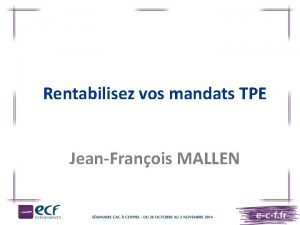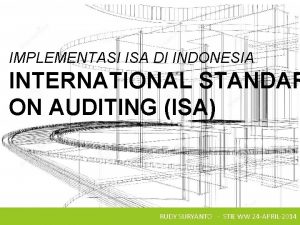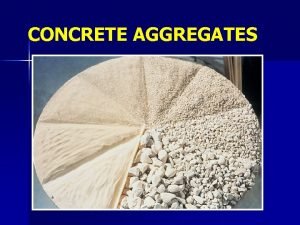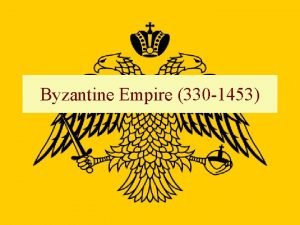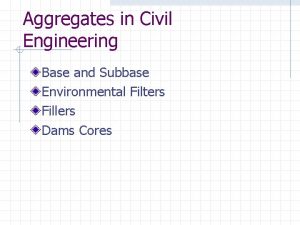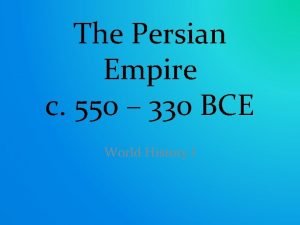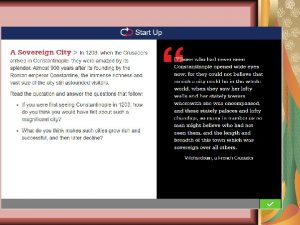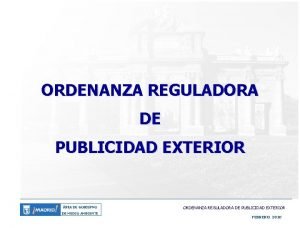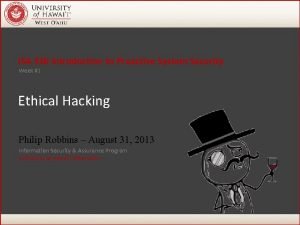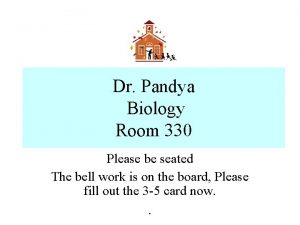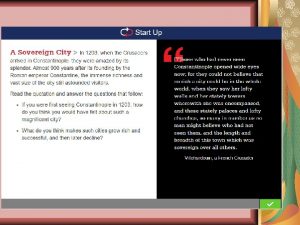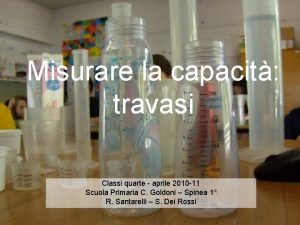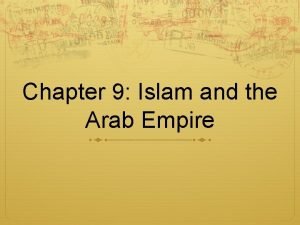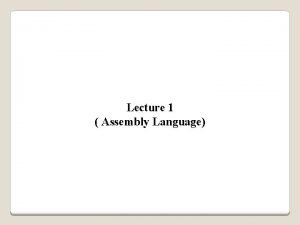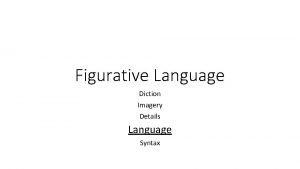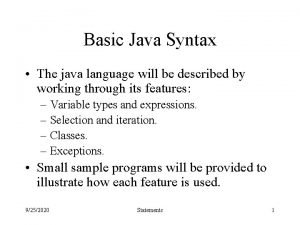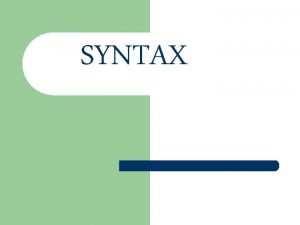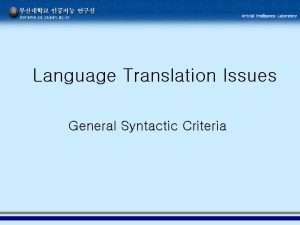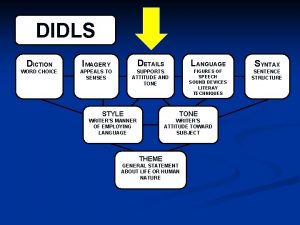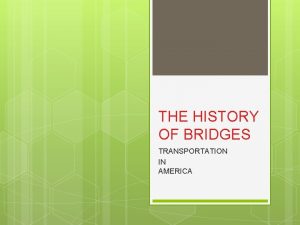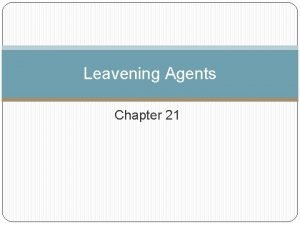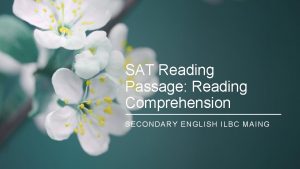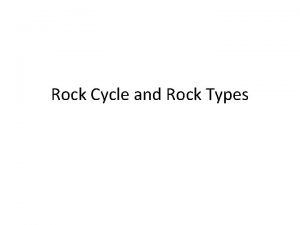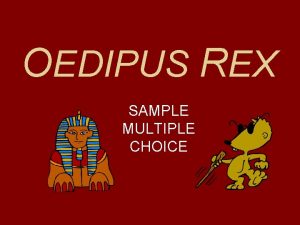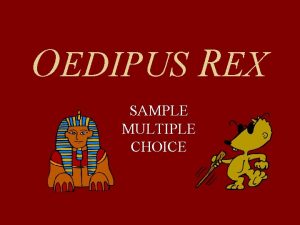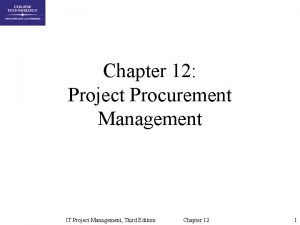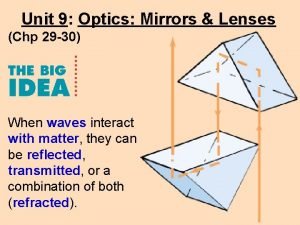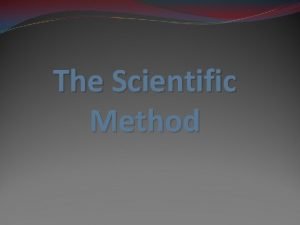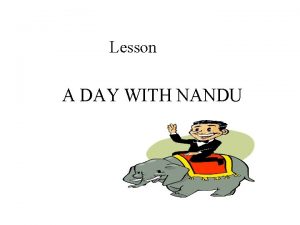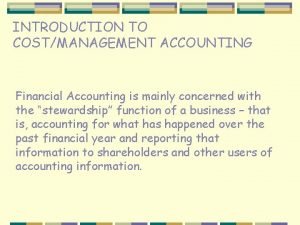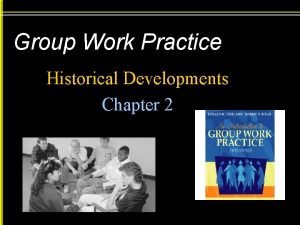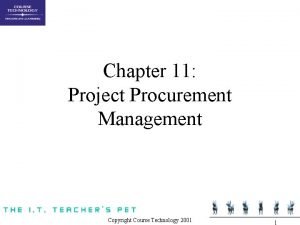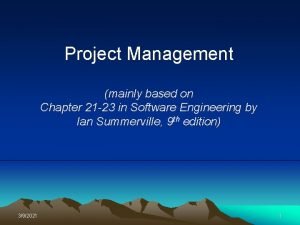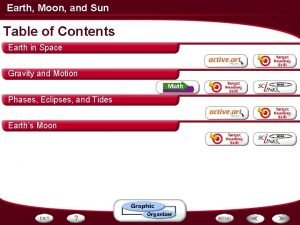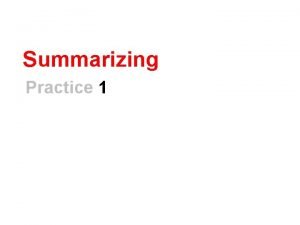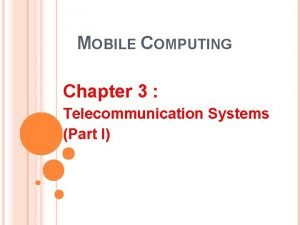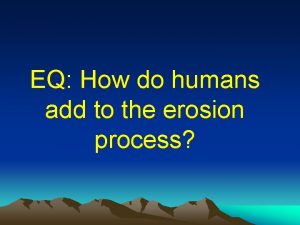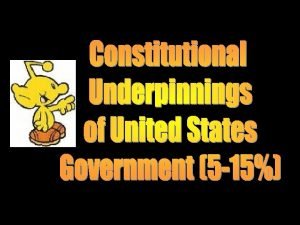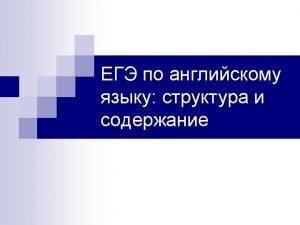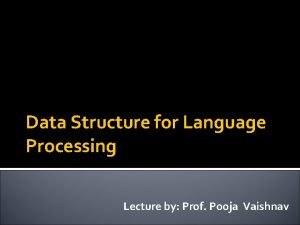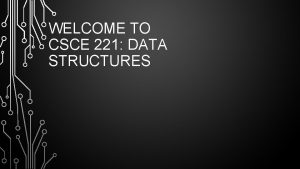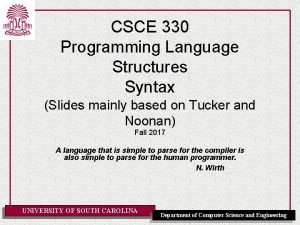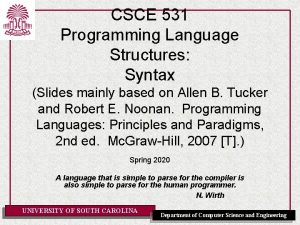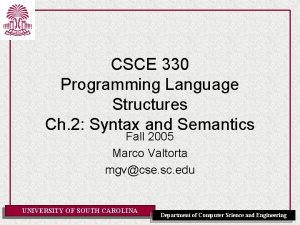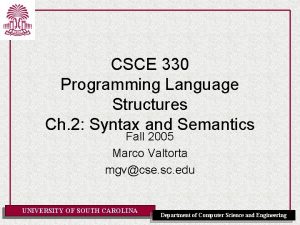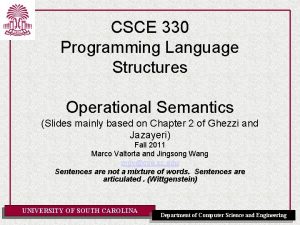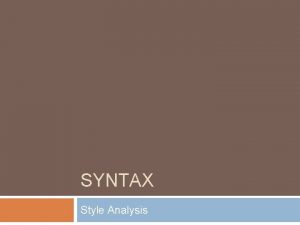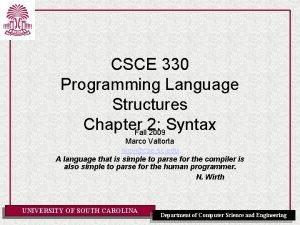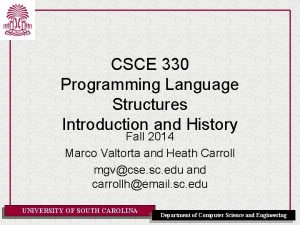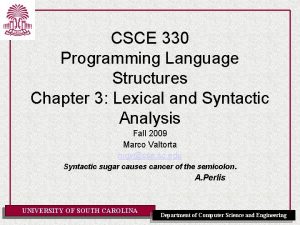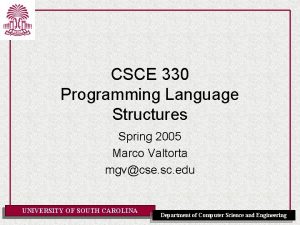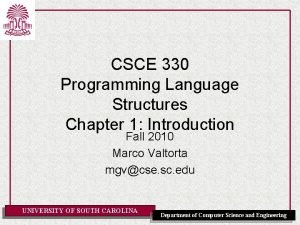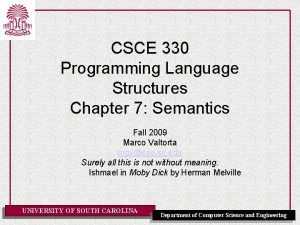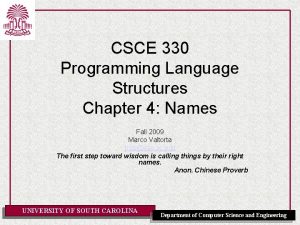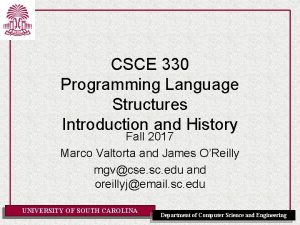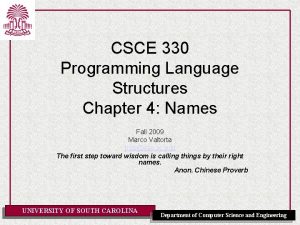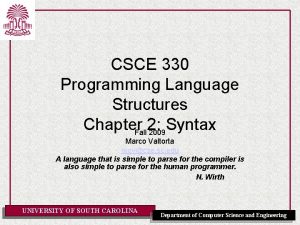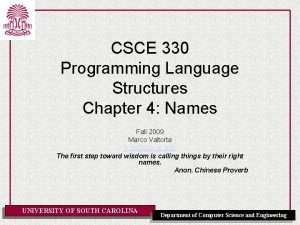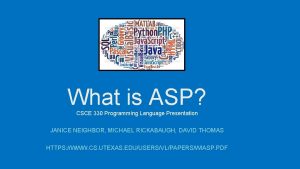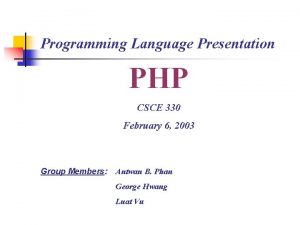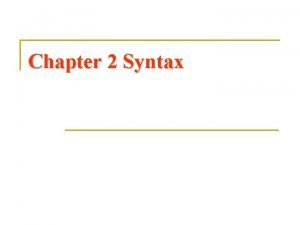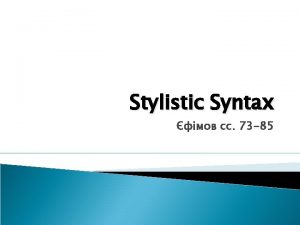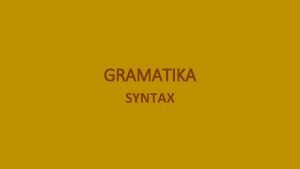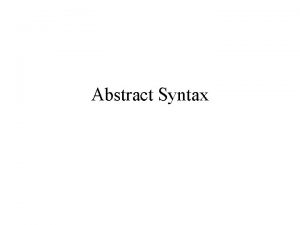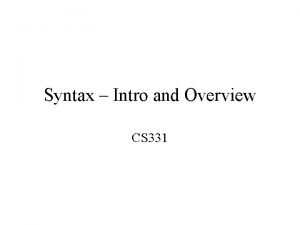CSCE 330 Programming Language Structures Syntax Slides mainly














































![EBNF Grammar from [G&J] (a) Syntax rules <program>: : ={ <statement>* } <statement>: : EBNF Grammar from [G&J] (a) Syntax rules <program>: : ={ <statement>* } <statement>: :](https://slidetodoc.com/presentation_image_h2/d5c699b033687e0b37875883e91d3b63/image-47.jpg)
![Syntax Diagrams from [G&J] UNIVERSITY OF SOUTH CAROLINA Department of Computer Science and Engineering Syntax Diagrams from [G&J] UNIVERSITY OF SOUTH CAROLINA Department of Computer Science and Engineering](https://slidetodoc.com/presentation_image_h2/d5c699b033687e0b37875883e91d3b63/image-48.jpg)


![Fig. 2. 7 [T] Clite Grammar: Statements Program int main ( ) { Declarations Fig. 2. 7 [T] Clite Grammar: Statements Program int main ( ) { Declarations](https://slidetodoc.com/presentation_image_h2/d5c699b033687e0b37875883e91d3b63/image-51.jpg)

































- Slides: 84

CSCE 330 Programming Language Structures Syntax (Slides mainly based on Tucker and Noonan) Fall 2011 Marco Valtorta and Jingsong Wang mgv@cse. sc. edu A language that is simple to parse for the compiler is also simple to parse for the human programmer. N. Wirth UNIVERSITY OF SOUTH CAROLINA Department of Computer Science and Engineering

Syntax and Semantics • Syntax is the set of rules that specify the composition of programs from letters, digits and other characters. • Semantics is the set of rules that specify what the result/outcome of a program is. • Problems with English language description of Syntax and Semantics: – verbosity – ambiguity UNIVERSITY OF SOUTH CAROLINA Department of Computer Science and Engineering

Contents 2. 1 Grammars 2. 1. 1 Backus-Naur Form 2. 1. 2 Derivations 2. 1. 3 Parse Trees 2. 1. 4 Associativity and Precedence 2. 1. 5 Ambiguous Grammars 2. 2 Extended BNF 2. 3 Syntax of a Small Language: Clite 2. 3. 1 Lexical Syntax 2. 3. 2 Concrete Syntax UNIVERSITY OF SOUTH CAROLINA Department of Computer Science and Engineering

Thinking about Syntax • The syntax of a programming language is a precise description of all its grammatically correct programs. • Precise syntax was first used with Algol 60, and has been used ever since. • Three levels: – Lexical syntax – Concrete syntax – Abstract syntax UNIVERSITY OF SOUTH CAROLINA Department of Computer Science and Engineering

Levels of Syntax • Lexical syntax = all the basic symbols of the language (names, values, operators, etc. ) • Concrete syntax = rules for writing expressions, statements and programs. • Abstract syntax = internal representation of the program, favoring content over form. E. g. , – C: if ( expr ). . . discard ( ) – Ada: if ( expr ) then discard then UNIVERSITY OF SOUTH CAROLINA Department of Computer Science and Engineering

2. 1 Grammars • A metalanguage is a language used to define other languages. • A grammar is a metalanguage used to define the syntax of a language. • Our interest: using grammars to define the syntax of a programming language. UNIVERSITY OF SOUTH CAROLINA Department of Computer Science and Engineering

The General Problem of Describing Syntax: Terminology • A sentence is a string of characters over some alphabet • A language is a set of sentences • A lexeme is the lowest level syntactic unit of a language (e. g. , *, sum, begin) • A token is a category of lexemes (e. g. , identifier) UNIVERSITY OF SOUTH CAROLINA 1 -7 Department of Computer Science and Engineering

Formal Definition of Languages • Recognizers – A recognition device reads input strings of the language and decides whether the input strings belong to the language – Example: syntax analysis part of a compiler • Generators – A device that generates sentences of a language – One can determine if the syntax of a particular sentence is correct by comparing it to the structure of the generator UNIVERSITY OF SOUTH CAROLINA 1 -8 Department of Computer Science and Engineering

Chomsky Hierarchy • Regular grammar -- least powerful • Context-free grammar (BNF) • Context-sensitive grammar • Unrestricted grammar Noam Chomsky, 1928 UNIVERSITY OF SOUTH CAROLINA Department of Computer Science and Engineering

Regular Grammar • Simplest; least powerful • Equivalent to: – Regular expression – Finite-state automaton • Right regular grammar: T*, A N, B N A→ B A→ UNIVERSITY OF SOUTH CAROLINA Department of Computer Science and Engineering

Example • Integer → 0 Integer | 1 Integer |. . . | 9 Integer | 0 | 1 |. . . | 9 UNIVERSITY OF SOUTH CAROLINA Department of Computer Science and Engineering

Context-Sensitive Grammars • Production: • α→β |α| ≤ |β| • α, β (N T)* • i. e. , left-hand side can be composed of strings of terminals and nonterminals UNIVERSITY OF SOUTH CAROLINA Department of Computer Science and Engineering

Unrestricted Grammar • Equivalent to: – Turing machine – von Neumann machine – C++, Java • That is, can compute any computable function. UNIVERSITY OF SOUTH CAROLINA Department of Computer Science and Engineering

2. 1. 1 Backus-Naur Form (BNF) • Stylized version of a context-free grammar (cf. Chomsky hierarchy) • Sometimes called Backus Normal Form • First used to define syntax of Algol 60 • Now used to define syntax of most major languages • Extended BNF – Improves readability and writability of BNF UNIVERSITY OF SOUTH CAROLINA Department of Computer Science and Engineering

BNF Grammar Set of productions: P terminal symbols: T nonterminal symbols: N start symbol: A production has the form where and UNIVERSITY OF SOUTH CAROLINA Department of Computer Science and Engineering

Example: Binary Digits Consider the grammar: binary. Digit 0 binary. Digit 1 or equivalently: binary. Digit 0 | 1 Here, | is a metacharacter that separates alternatives. UNIVERSITY OF SOUTH CAROLINA Department of Computer Science and Engineering

2. 1. 2 Derivations Consider the following grammar (Ginteger): Integer Digit | Integer Digit 0 | 1 | 2 | 3 | 4 | 5 | 6 | 7 | 8 | 9 We can derive any unsigned integer, like 352, from this grammar. UNIVERSITY OF SOUTH CAROLINA Department of Computer Science and Engineering

Derivation of 352 as an Integer A 6 -step process, starting with: Integer UNIVERSITY OF SOUTH CAROLINA Department of Computer Science and Engineering

Derivation of 352 (step 1) Use a grammar rule to enable each step: Integer Digit UNIVERSITY OF SOUTH CAROLINA Department of Computer Science and Engineering

Derivation of 352 (steps 1 -2) Replace a nonterminal by a right-hand side of one of its rules: Integer Digit Integer 2 UNIVERSITY OF SOUTH CAROLINA Department of Computer Science and Engineering

Derivation of 352 (steps 1 -3) Each step follows from the one before it. Integer Digit Integer 2 Integer Digit 2 UNIVERSITY OF SOUTH CAROLINA Department of Computer Science and Engineering

Derivation of 352 (steps 1 -4) Integer Digit Integer 2 Integer Digit 2 Integer 5 2 UNIVERSITY OF SOUTH CAROLINA Department of Computer Science and Engineering

Derivation of 352 (steps 1 -5) Integer Digit Integer 2 Integer Digit 2 Integer 5 2 Digit 5 2 UNIVERSITY OF SOUTH CAROLINA Department of Computer Science and Engineering

Derivation of 352 (steps 1 -6) You know you’re finished when there are only terminal symbols remaining. Integer Digit Integer 2 Integer Digit 2 Integer 5 2 Digit 5 2 352 UNIVERSITY OF SOUTH CAROLINA Department of Computer Science and Engineering

A Different Derivation of 352 Integer Digit Digit 3 Digit 3 5 Digit 352 This is called a leftmost derivation, since at each step the leftmost nonterminal is replaced. (The first one was a rightmost derivation. ) UNIVERSITY OF SOUTH CAROLINA Department of Computer Science and Engineering

Notation for Derivations Integer * 352 Means that 352 can be derived in a finite number of steps using the grammar for Integer. 352 L(G) Means that 352 is a member of the language defined by grammar G. L(G) = { T* | Integer * } Means that the language defined by grammar G is the set of all symbol strings that can be derived as an Integer. UNIVERSITY OF SOUTH CAROLINA Department of Computer Science and Engineering

2. 1. 3 Parse Trees • A parse tree is a graphical representation of a derivation. The root of the tree is the start symbol. Each internal node of the tree corresponds to a step in the derivation. The children of a node represent a right-hand side of a production. Each leaf node represents a symbol of the derived string, reading from left to right. UNIVERSITY OF SOUTH CAROLINA Department of Computer Science and Engineering

E. g. , The step Integer Digit appears in the parse tree as: Integer UNIVERSITY OF SOUTH CAROLINA Digit Department of Computer Science and Engineering

Parse Tree for 352 as an Integer Figure 2. 1 UNIVERSITY OF SOUTH CAROLINA Department of Computer Science and Engineering

Arithmetic Expression Grammar The following grammar defines the language of arithmetic expressions with 1 -digit integers, addition, and subtraction. Expr + Term | Expr – Term | Term 0 |. . . | 9 | ( Expr ) UNIVERSITY OF SOUTH CAROLINA Department of Computer Science and Engineering

Parse of the String 5 -4+3 Figure 2. 2 UNIVERSITY OF SOUTH CAROLINA Department of Computer Science and Engineering

Contents 2. 1 Grammars 2. 1. 1 Backus-Naur Form 2. 1. 2 Derivations 2. 1. 3 Parse Trees 2. 1. 4 Associativity and Precedence 2. 1. 5 Ambiguous Grammars 2. 2 Extended BNF 2. 3 Syntax of a Small Language: Clite 2. 3. 1 Lexical Syntax 2. 3. 2 Concrete Syntax UNIVERSITY OF SOUTH CAROLINA Department of Computer Science and Engineering

2. 1. 4 Associativity and Precedence • A grammar can be used to define associativity and precedence among the operators in an expression. E. g. , + and - are left-associative operators in mathematics; * and / have higher precedence than + and -. • Consider the grammar G 1: Expr -> Expr + Term | Expr – Term | Term -> Term * Factor | Term / Factor | Term % Factor | Factor -> Primary ** Factor | Primary -> 0 CAROLINA |. . . | 9 | ( Expr ) UNIVERSITY OF SOUTH Department of Computer Science and Engineering

Parse of 4**2**3+5*6+7 for Grammar G 1 Figure 2. 3 UNIVERSITY OF SOUTH CAROLINA Department of Computer Science and Engineering

Associativity and Precedence for Grammar G 1 Table 2. 1 Precedence 3 2 1 Associativity Operators right ** left * / % left + - Note: These relationships are shown by the structure of the parse tree: highest precedence at the bottom, and left-associativity on the left at each level. UNIVERSITY OF SOUTH CAROLINA Department of Computer Science and Engineering

2. 1. 5 Ambiguous Grammars • A grammar is ambiguous if one of its strings has two or more different parse trees. E. g. , Grammar G 1 above is unambiguous. • C, C++, and Java have a large number of – operators and – precedence levels • Instead of using a large grammar, we can: – Write a smaller ambiguous grammar, and – Give separate precedence and associativity (e. g. , Table 2. 1) UNIVERSITY OF SOUTH CAROLINA Department of Computer Science and Engineering

An Ambiguous Expression Grammar G 2 Expr -> Expr Op Expr | ( Expr ) | Integer Op -> + | - | * | / | % | ** Notes: G 2 is equivalent to G 1. i. e. , its language is the same. G 2 has fewer productions and nonterminals than G 1. However, G 2 is ambiguous. UNIVERSITY OF SOUTH CAROLINA Department of Computer Science and Engineering

Ambiguous Parse of 5 -4+3 Using Grammar G 2 Figure 2. 4 UNIVERSITY OF SOUTH CAROLINA Department of Computer Science and Engineering

The Dangling Else If. Statement -> if ( Expression ) Statement | if ( Expression ) Statement else Statement -> Assignment | If. Statement | Block -> { Statements } Statements -> Statements Statement | Statement UNIVERSITY OF SOUTH CAROLINA Department of Computer Science and Engineering

Example of Dangling Else With which ‘if’ does the following ‘else’ associate? if (x < 0) if (y < 0) y = y - 1; else y = 0; Answer: either one! UNIVERSITY OF SOUTH CAROLINA Department of Computer Science and Engineering

The Dangling Else Ambiguity Figure 2. 5 UNIVERSITY OF SOUTH CAROLINA Department of Computer Science and Engineering

Solving the dangling else ambiguity 1. Algol 60, C, C++: associate each else with closest if; use {} or begin…end to override. 2. Algol 68, Modula, Ada: use explicit delimiter to end every conditional (e. g. , if…fi) 3. Java: rewrite the grammar to limit what can appear in a conditional: If. Then. Statement -> if ( Expression ) Statement If. Then. Else. Statement -> if ( Expression ) Statement. No. Short. If else Statement The category Statement. No. Short. If includes all statements except If. Then. Statement. UNIVERSITY OF SOUTH CAROLINA Department of Computer Science and Engineering

2. 2 Extended BNF (EBNF) • BNF: – recursion for iteration – nonterminals (abstractions) for grouping • EBNF: additional metacharacters – { } for a series of zero or more – ( ) for a list, must pick one – [ ] for an optional list; pick none or one UNIVERSITY OF SOUTH CAROLINA Department of Computer Science and Engineering

EBNF Examples Expression is a list of one or more Terms separated by operators + and Expression -> Term { ( + | - ) Term } If. Statement -> if ( Expression ) Statement [ else Statement ] C-style EBNF lists alternatives vertically and uses opt to signify optional parts. E. g. , If. Statement: if ( Expression ) Statement Else. Partopt Else. Part: else Statement UNIVERSITY OF SOUTH CAROLINA Department of Computer Science and Engineering

EBNF to BNF We can always rewrite an EBNF grammar as a BNF grammar. E. g. , A -> x { y } z can be rewritten: A -> x A' z A' -> e| y A' (The letter e stands for the empty string. ) (Rewriting EBNF rules with ( ), [ ] is left as an exercise. ) While EBNF is no more powerful than BNF, its rules are often simpler. Department and clearer. UNIVERSITY OF SOUTH CAROLINA of Computer Science and Engineering

Syntax Diagram for Expressions with Addition UNIVERSITY OF SOUTH CAROLINA Department of Computer Science and Engineering
![EBNF Grammar from GJ a Syntax rules program statement statement EBNF Grammar from [G&J] (a) Syntax rules <program>: : ={ <statement>* } <statement>: :](https://slidetodoc.com/presentation_image_h2/d5c699b033687e0b37875883e91d3b63/image-47.jpg)
EBNF Grammar from [G&J] (a) Syntax rules <program>: : ={ <statement>* } <statement>: : =<assignment> | <conditional> | <loop> <assignment>: : =<identifier> =<expr>; <conditional>: : =if<expr> {<statement>+ } | if<expr> { <statement>+ } else { <statement>+ } <loop>: : =while<expr> { <statement>+ } <expr> : : =<identifier> | <number>| (<expr>) | <expr><operator><expr> (b) Lexical rules <operator>: : = + | - | * | / | = | ≠ | < | > | ≤ | ≥ <identifier>: : = <letter> <ld>* <ld>: : = <letter> | <digit> <number>: : = <digit>+ <letter>: : = a | b | c | … | z <digit>: : = 0 | 1 | … | 9 UNIVERSITY OF SOUTH CAROLINA Department of Computer Science and Engineering
![Syntax Diagrams from GJ UNIVERSITY OF SOUTH CAROLINA Department of Computer Science and Engineering Syntax Diagrams from [G&J] UNIVERSITY OF SOUTH CAROLINA Department of Computer Science and Engineering](https://slidetodoc.com/presentation_image_h2/d5c699b033687e0b37875883e91d3b63/image-48.jpg)
Syntax Diagrams from [G&J] UNIVERSITY OF SOUTH CAROLINA Department of Computer Science and Engineering

Contents 2. 1 Grammars 2. 1. 1 Backus-Naur Form 2. 1. 2 Derivations 2. 1. 3 Parse Trees 2. 1. 4 Associativity and Precedence 2. 1. 5 Ambiguous Grammars 2. 2 Extended BNF 2. 3 Syntax of a Small Language: Clite 2. 3. 1 Lexical Syntax 2. 3. 2 Concrete Syntax UNIVERSITY OF SOUTH CAROLINA Department of Computer Science and Engineering

2. 3 Syntax of a Small Language: Clite • Motivation for using a subset of C: Language Pascal C C++ Java Grammar (pages) Reference 5 Jensen & Wirth 6 Kernighan & Richie 22 Stroustrup 14 Gosling, et. al. • The Clite grammar fits on one page (Figure 2. 7 on p. 38 [T]; next 3 slides), so it’s a far better tool for studying language design. UNIVERSITY OF SOUTH CAROLINA Department of Computer Science and Engineering
![Fig 2 7 T Clite Grammar Statements Program int main Declarations Fig. 2. 7 [T] Clite Grammar: Statements Program int main ( ) { Declarations](https://slidetodoc.com/presentation_image_h2/d5c699b033687e0b37875883e91d3b63/image-51.jpg)
Fig. 2. 7 [T] Clite Grammar: Statements Program int main ( ) { Declarations Statements } Declarations { Declaration } Declaration Type Identifier [ [ Integer ] ] { , Identifier [ [ Integer ] ] Type int | bool | float | char }; Statements { Statement } Statement ; | Block | Assignment | If. Statement | While. Statement Block { Statements } Assignment Identifier [ [ Expression ] ] = Expression ; If. Statement if ( Expression ) Statement [ else Statement ] While. Statement while ( Expression ) Statement UNIVERSITY OF SOUTH CAROLINA Department of Computer Science and Engineering

Fig. 2. 7 Clite Grammar: Expressions Expression Conjunction { || Conjunction } Conjunction Equality { && Equality } Equality Relation [ Equ. Op Relation ] Equ. Op == | != Relation Addition [ Rel. Op Addition ] Rel. Op < | <= | >= Addition Term { Add. Op Term } Add. Op + | Term Factor { Mul. Op Factor } Mul. Op * | / | % Factor [ Unary. Op ] Primary Unary. Op - | ! Primary Identifier [ [ Expression ] ] | Literal | ( Expression ) | Type ( Expression ) UNIVERSITY OF SOUTH CAROLINA Department of Computer Science and Engineering

Fig. 2. 7 Clite grammar: lexical level Identifier Letter { Letter | Digit } Letter a | b |. . . | z | A | B |. . . | Z Digit 0 | 1 |. . . | 9 Literal Integer | Boolean | Float | Char Integer Digit { Digit } Boolean true | False Float Integer Char ‘ ASCII Char ‘ UNIVERSITY OF SOUTH CAROLINA Department of Computer Science and Engineering

Issues Not Addressed by this Grammar • Comments • Whitespace • Distinguishing one token <= from two tokens < = • Distinguishing identifiers from keywords like if • These issues are addressed by identifying two levels: – lexical level – syntactic level • All issues above are lexical ones UNIVERSITY OF SOUTH CAROLINA Department of Computer Science and Engineering

2. 3. 1 Lexical Syntax • Input: a stream of characters from the ASCII set, keyed by a programmer. • Output: a stream of tokens or basic symbols, classified as follows: – Identifiers e. g. , Stack, x, i, push – Literals e. g. , 123, 'x', 3. 25, true – Keywords bool char else false float if int main true while – Operators e. g. , = || && == != < <= > >= + - * / ! – Punctuation ; , { } ( ) • “A token is a logically cohesive sequence of characters representing a single symbol” [T, p. 60] UNIVERSITY OF SOUTH CAROLINA Department of Computer Science and Engineering

Scan: Divide Input into Tokens An example mini Triangle source program: let var y: Integer Scan is a synonim of lexically analyze in !new year Tokens are “words” in the input, for y : = y+1 example keywords, operators, scanner identifiers, literals, etc. let . . . ident. y var ident. y becomes : = colon : ident. y UNIVERSITY OF SOUTH CAROLINA op. + ident. Integer in in intlit 1 eot . . . Department of Computer Science and Engineering

Developing a Scanner The scanner will return an array of Tokens: public class Token { byte kind; String spelling; final static byte IDENTIFIER = 0; INTLITERAL = 1; OPERATOR = 2; BEGIN = 3; CONST = 4; . . . public Token(byte kind, String spelling) { this. kind = kind; this. spelling = spelling; if spelling matches a keyword change my kind automatically }. . . } UNIVERSITY OF SOUTH CAROLINA Department of Computer Science and Engineering

Whitespace is any space, tab, end-of-line character (or characters), or character sequence inside a comment No token may contain embedded whitespace (unless it is a character or string literal) Example: >= one token > = two tokens UNIVERSITY OF SOUTH CAROLINA Department of Computer Science and Engineering

Whitespace Examples in Pascal • while a < b do • while a<b do legal - spacing between tokens spacing not needed for < • whilea<bdo boundaries • whilea < bdo UNIVERSITY OF SOUTH CAROLINA illegal - can’t tell between tokens Department of Computer Science and Engineering

Comments • Not defined in grammar • Clite uses // comment style of C++ UNIVERSITY OF SOUTH CAROLINA Department of Computer Science and Engineering

Identifier • Sequence of letters and digits, starting with a letter • • if is both an identifier and a keyword Most languages require identifiers to be distinct from keywords • In some languages, keywords are merely predefined (and thus can be redefined by the programmer) UNIVERSITY OF SOUTH CAROLINA Department of Computer Science and Engineering

Redefining Identifiers can be dangerous program confusing; const true = false; begin if (a<b) = true then f(a) else … UNIVERSITY OF SOUTH CAROLINA Department of Computer Science and Engineering

Should Identifiers be casesensitive? • Older languages: no. Why? – Pascal: no. – Modula: yes – C, C++: yes – Java: yes – PHP: partly yes, partly no. What about orthogonality? UNIVERSITY OF SOUTH CAROLINA Department of Computer Science and Engineering

2. 3. 2 Concrete Syntax Based on a parse of its Tokens ; is a statement terminator (Algol-60, Pascal use ; as a separator) Rule for If. Statement is ambiguous: “The else ambiguity is resolved by connecting an else with the last encountered else-less if. ” [Stroustrup, 1991] UNIVERSITY OF SOUTH CAROLINA Department of Computer Science and Engineering

Expressions in Clite 13 grammar rules Use of meta braces – operators are left associative C++ expressions require 4 pages of grammar rules [Stroustrup] C uses an ambiguous expression grammar [Kernighan and Ritchie] UNIVERSITY OF SOUTH CAROLINA Department of Computer Science and Engineering

Associativity and Precedence • • Clite Operator Unary - ! */ +< <= > >= == != && || Associativity none left UNIVERSITY OF SOUTH CAROLINA Department of Computer Science and Engineering

Clite Equality, Relational Operators • … are non-associative (an idea borrowed from Ada) • Why is this important? In C++, the expression: if (a < x < b) is not equivalent to if (a < x && x < b) But it is error-free! So, what does it mean? UNIVERSITY OF SOUTH CAROLINA Department of Computer Science and Engineering

Bonus Slides 2. 1 Grammars 2. 1. 1 Backus-Naur Form 2. 1. 2 Derivations 2. 1. 3 Parse Trees 2. 1. 4 Associativity and Precedence 2. 1. 5 Ambiguous Grammars 2. 2 Extended BNF 2. 3 Syntax of a Small Language: Clite 2. 3. 1 Lexical Syntax 2. 3. 2 Concrete Syntax 2. 4 Compilers and Interpreters 2. 5 Linking Syntax and Semantics 2. 5. 1 Abstract Syntax 2. 5. 2 Abstract Syntax Trees 2. 5. 3 Abstract Syntax of Clite UNIVERSITY OF SOUTH CAROLINA Department of Computer Science and Engineering

Lexical Analyzer Syntactic Analyzer Semantic Analyzer UNIVERSITY OF SOUTH CAROLINA de ( e Co diat Inte rme diat rme Inte Abs trac t To Source Program ken s Syn tax e Co de ( IC ) IC) 2. 4 Compilers and Interpreters Code Optimizer Code Generator Machine Code Department of Computer Science and Engineering

Lexer • Based on a regular grammar, simpler than the context-free grammars described in EBNF • Input: characters • Output: tokens • Separate: – Speed: 75% of time for non-optimizing – Simpler design – Character sets – End of line conventions UNIVERSITY OF SOUTH CAROLINA Department of Computer Science and Engineering

Parser • • Based on BNF/EBNF grammar Input: tokens Output: abstract syntax tree (parse tree) Abstract syntax: parse tree with punctuation, many nonterminals discarded UNIVERSITY OF SOUTH CAROLINA Department of Computer Science and Engineering

Semantic Analysis • Check that all identifiers are declared • Perform type checking • Insert implied conversion operators (i. e. , make them explicit) • Sometimes called contextual analysis, and including the determination of scope UNIVERSITY OF SOUTH CAROLINA Department of Computer Science and Engineering

Code Optimization • Evaluate constant expressions at compiletime • Reorder code to improve cache performance • Eliminate common subexpressions • Eliminate unnecessary code UNIVERSITY OF SOUTH CAROLINA Department of Computer Science and Engineering

Code Generation • • Output: machine code Instruction selection Register management Peephole optimization UNIVERSITY OF SOUTH CAROLINA Department of Computer Science and Engineering

Interpreter • Replaces last 2 phases of a compiler • Input: – Mixed: intermediate code – Pure: stream of ASCII characters • Mixed interpreters – Java, Perl, Python, Haskell, Scheme • Pure interpreters: – most Basics, shell commands UNIVERSITY OF SOUTH CAROLINA Department of Computer Science and Engineering

2. 5 Linking Syntax and Semantics • Output: parse tree is inefficient • Example: Fig. 2. 9 (next slide) UNIVERSITY OF SOUTH CAROLINA Department of Computer Science and Engineering

Parse Tree for z = x + 2*y; Fig. 2. 9 UNIVERSITY OF SOUTH CAROLINA Department of Computer Science and Engineering

Finding a More Efficient Tree • The shape of the parse tree reveals the meaning of the program. • So we want a tree that removes its inefficiency and keeps its shape. – Remove separator/punctuation terminal symbols – Remove all trivial root nonterminals – Replace remaining nonterminals with leaf terminals • Example: Fig. 2. 10 (next slide) UNIVERSITY OF SOUTH CAROLINA Department of Computer Science and Engineering

Abstract Syntax Tree for z = x + 2*y; Fig. 2. 10 UNIVERSITY OF SOUTH CAROLINA Department of Computer Science and Engineering

Abstract Syntax Removes “syntactic sugar” and keeps essential elements of a language. E. g. , consider the following two equivalent loops: Pascal while i < n do begin C/C++ while (i < n) { i : = i + 1; end; i = i + 1; } The only essential information in each of these is 1) that it is a loop, 2) that its terminating condition is i < n, and 3) that its body increments the current value of i. UNIVERSITY OF SOUTH CAROLINA Department of Computer Science and Engineering

Abstract Syntax of Clite Assignments Assignment = Variable target; Expression source [[The RHS of the rule above is a list of named essential elements that compose the LHS]] Expression = Variable. Ref | Value | Binary | Unary [[The RHS of the rule above has a list of alternatives for the LHS--This type of rule translates into an abstract class in a Java lexer]] Variable. Ref = Variable | Array. Ref Variable = String id Array. Ref = String id; Expression index Value = Int. Value | Bool. Value | Float. Value | Char. Value Binary = Operator op; Expression term 1, term 2 Unary = Unary. Op op; Expression term Operator = Arithmetic. Op | Relational. Op | Boolean. Op Int. Value = Integer int. Value … UNIVERSITY OF SOUTH CAROLINA Department of Computer Science and Engineering

Abstract Syntax as Java Classes abstract class Expression { } abstract class Variable. Ref extends Expression { } class Variable extends Variable. Ref { String id; } class Value extends Expression { … } class Binary extends Expression { Operator op; Expression term 1, term 2; } class Unary extends Expression { Unary. Op op; Expression term; } UNIVERSITY OF SOUTH CAROLINA Department of Computer Science and Engineering

Example Abstract Syntax Tree op term 1 term 2 • Binary node Binary • Abstract Syntax Tree • for x+2*y (Fig 2. 13) Operator Variable + Binary x Operator UNIVERSITY OF SOUTH CAROLINA * Value 2 Variable y Department of Computer Science and Engineering

Remaining Abstract Syntax of Clite (Declarations and Statements) Fig 2. 14 UNIVERSITY OF SOUTH CAROLINA Department of Computer Science and Engineering
 Syntax directed translation
Syntax directed translation A small child slides down the four frictionless slides
A small child slides down the four frictionless slides A child is on a playground swing motionless
A child is on a playground swing motionless Syntax programming
Syntax programming Define syntax in programming
Define syntax in programming Homology
Homology Class counter
Class counter Dynamic programming slides
Dynamic programming slides Hardware description language vs programming language
Hardware description language vs programming language C++ control structures
C++ control structures Perbedaan linear programming dan integer programming
Perbedaan linear programming dan integer programming Greedy algorithm vs dynamic programming
Greedy algorithm vs dynamic programming What is system programing
What is system programing Integer programming vs linear programming
Integer programming vs linear programming Definisi integer
Definisi integer S-330 test answers
S-330 test answers Task force leader responsibilities
Task force leader responsibilities Art 340 cp
Art 340 cp 1453-395
1453-395 1453-330
1453-330 395-1453
395-1453 Procentmetoden
Procentmetoden 330
330 Stats 330
Stats 330 Oracle database 11g express edition 설치
Oracle database 11g express edition 설치 Csci 330
Csci 330 Indica la forma correcta de cada verbo en el imperfecto.
Indica la forma correcta de cada verbo en el imperfecto. The roman principate (31 bce- 330 ce) was installed by
The roman principate (31 bce- 330 ce) was installed by Bts 330
Bts 330 Stats 330
Stats 330 Nep 330
Nep 330 Isa 330 bahasa indonesia
Isa 330 bahasa indonesia Astm c 330
Astm c 330 Definition of byzantium
Definition of byzantium Astm c33 sand gradation
Astm c33 sand gradation 550+330
550+330 649+330
649+330 Ce1453
Ce1453 Ordenanza 330 de publicidad exterior
Ordenanza 330 de publicidad exterior Isa 330
Isa 330 Room 330
Room 330 What happened in 330 ce
What happened in 330 ce Actimel quanti ml
Actimel quanti ml Stats 330
Stats 330 Squawk codes
Squawk codes 1453-330
1453-330 Assembly language examples
Assembly language examples What is figurative language how about diction
What is figurative language how about diction Java language syntax
Java language syntax Syntax
Syntax Criteria language syntax
Criteria language syntax Details didls
Details didls What is islam's sacred text
What is islam's sacred text The earliest bridges consisted mainly of
The earliest bridges consisted mainly of Single acting baking powder
Single acting baking powder Pure liquid dielectrics example
Pure liquid dielectrics example Woolf uses the word we throughout the passage mainly to *
Woolf uses the word we throughout the passage mainly to * Composed mainly of minerals with blocky crystal shapes
Composed mainly of minerals with blocky crystal shapes Unlike other characters in the play creon displays
Unlike other characters in the play creon displays Oedipus multiple choice questions
Oedipus multiple choice questions Adulteration of dal with kesari dal mainly causes
Adulteration of dal with kesari dal mainly causes For forced draught system the function of chimney is mainly
For forced draught system the function of chimney is mainly Solicitation planning in project management
Solicitation planning in project management The action of lenses depends mainly on
The action of lenses depends mainly on Diagrams tables and graphs are used by scientists mainly to
Diagrams tables and graphs are used by scientists mainly to Worksheet on a day with nandu
Worksheet on a day with nandu Cost accounting is mainly concerned with
Cost accounting is mainly concerned with The disadvantages of franchising mainly affect
The disadvantages of franchising mainly affect H.323 vs sip
H.323 vs sip The dutch settled new netherland primarily to
The dutch settled new netherland primarily to Group work grew up mainly in
Group work grew up mainly in Project procurement management mainly involves
Project procurement management mainly involves Financial management mainly focuses on
Financial management mainly focuses on Fractional distillation
Fractional distillation The phases of moon occur mainly due to
The phases of moon occur mainly due to Yellowstone national park is mainly located in wyoming
Yellowstone national park is mainly located in wyoming Reseller markets consist mainly of
Reseller markets consist mainly of Gsm protocols
Gsm protocols Bagian rhizopus
Bagian rhizopus Which is mainly responsible for preventing erosion
Which is mainly responsible for preventing erosion What does the story mainly tell us about?
What does the story mainly tell us about? Lobbyists try to influence legislators mainly through
Lobbyists try to influence legislators mainly through The narrator was brought up mainly in
The narrator was brought up mainly in Data structures for language processing
Data structures for language processing Csce 221 tamu syllabus
Csce 221 tamu syllabus



